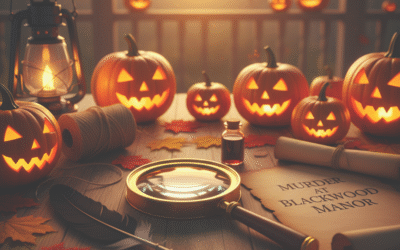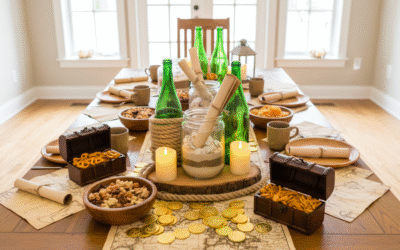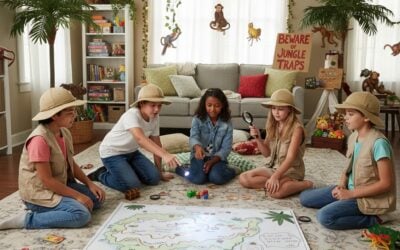Why Your Room Setup Matters More Than You Think
If you’re hosting a murder mystery game night, the story and characters matter, but the environment is what transforms the evening from “fun” to “unforgettable.” Think about it: your guests can read their character cards anywhere, but when they walk into a space that feels like an actual crime scene, they’ll lean into their roles without hesitation. That’s the difference between a regular game night and an immersive experience. If you’ve ever wondered how to make your players gasp when they walk in the door, you’re in the right place.
Step One: Choose the Right Atmosphere
The foundation of any crime scene party setup is atmosphere. Do you want your mystery to feel suspenseful, adventurous, or a little silly? That choice drives everything else. For example, if you’re running The Emerald Expedition, vines, lanterns, and artifacts will transport guests into the jungle. Hosting a train mystery? Vintage luggage and table lamps instantly set the tone. Start with a theme, then build your crime scene around it.
Step Two: Layout That Encourages Drama
Layout isn’t just about where people sit. It’s about directing the flow of the story. Think of yourself as the stage manager of a play where everyone’s an actor. A good crime scene party setup uses space strategically:
- Focal Point: Decide where the “crime” happened. This could be a staged area with a tipped-over chair, a broken lantern, or a suspicious trunk. Make sure everyone has to walk by it at least once.
- Movement Paths: Leave enough open space for mingling, side conversations, and dramatic confrontations. If people feel cramped, the energy fizzles.
- Hidden Corners: Every good mystery needs nooks where secrets can be whispered. A corner with dim lighting or a curtained alcove makes players feel like they’re sneaking around.
Step Three: Lighting That Does the Heavy Lifting
Lighting is the secret weapon of atmosphere. Overhead lights are fine for board games, but for mysteries, they ruin the mood. Instead, layer your lighting:
- Warm Base: Use lamps, string lights, or lanterns to create a soft glow. This keeps the room cozy without being too dark.
- Spot Highlights: Aim a lamp or flashlight at your “crime scene.” It draws attention like a stage spotlight.
- Shadows and Mystery: Candles (real or battery-operated) cast flickering shadows that keep guests guessing. Dim corners make conversations feel private and tense.
The right lighting makes even a plastic prop look cinematic.
Props: The Power of Suggestion
You don’t need to spend a fortune to make your setup believable. Everyday items can double as evidence. A knocked-over glass becomes a potential clue. A coat draped across a chair looks like someone left in a hurry. If you want inspiration, the Jungle Expedition mystery hosting guide shows how simple props like maps and compasses can create an authentic vibe without cluttering the space.
Seating: The Underestimated Detail
Seating affects more than comfort; it shapes the game. Place chairs in clusters so conversations can happen naturally. Don’t line people up like a classroom. Round tables or loose living room arrangements are best. And always leave at least one “empty” seat at the table—it gives players somewhere to gesture when accusing the missing suspect, even if it’s just an empty chair.
Sound and Smell: The Forgotten Layers
Sight gets most of the attention, but sound and smell anchor memory. Play background music that matches your theme—jungle drums, vintage jazz, or desert winds. Keep it low so people can still talk. For scent, a cinnamon candle, a whiff of sandalwood, or even a pot of coffee brewing can make your crime scene feel alive. Just avoid overpowering smells that might distract from the story.
Don’t Overcrowd With Decorations
One mistake hosts make is overloading the room with props. You want immersion, not a cluttered garage sale. Stick to three to five strong visual elements. For example, in a western mystery like Murder at Copper Gulch, a cowboy hat, a lantern, and a rope draped over a chair is plenty. It sparks imagination without overwhelming your guests.
Using Lighting for the Big Reveal
Here’s a pro move: when the moment of accusation comes, change the lighting. Maybe you turn off the main lights and leave only candles glowing. Or you click on a single flashlight pointed at the accused. That shift in mood makes the reveal unforgettable. It’s a trick directors use on stage, and it works just as well in your living room.
Creating Flow Between Rooms
If your home has multiple rooms, use them. The kitchen can be the “camp,” the dining room the “crime scene,” and the living room the “investigation hub.” This lets guests move between spaces naturally, just like characters in a story. It also prevents the dreaded bottleneck of everyone crowding into one spot.
Tips for Small Spaces
Not everyone has a giant hosting area, and that’s okay. Small spaces can actually heighten tension. Push furniture to the sides to open the floor. Use vertical space: hang vines, drape fabric, or set props on shelves. Even a one-bedroom apartment can feel like a dangerous train ride on the Grand Gilded Express with clever staging.
The Ultimate Trick: Involve the Guests in the Setup
Want instant buy-in? Give guests props or small setup tasks when they arrive. Hand someone a lantern to place, let another person scatter “evidence,” or ask one guest to light the candles. Suddenly, they’re not just players—they’re part of building the crime scene. It hooks them from the first minute.
Final Thoughts: Keep It Simple, Keep It Fun
A great crime scene party setup doesn’t require a Hollywood budget. The best rooms rely on atmosphere, layout, and lighting—three things you control. If you can make your guests feel like they’ve stepped into the middle of a story, you’ve already won. The mystery itself will do the rest.
For more inspiration on bringing your mystery night to life, check out our detailed guide on how to host a jungle expedition murder mystery. Pair that with the right game kit, and your living room transforms into the ultimate stage for intrigue.




0 Comments